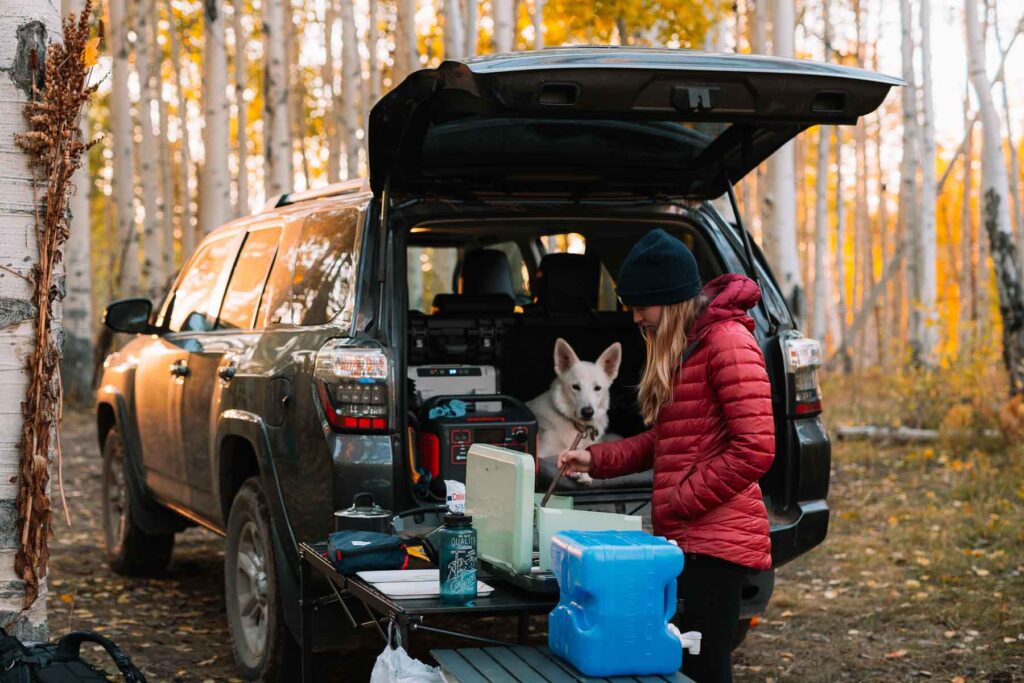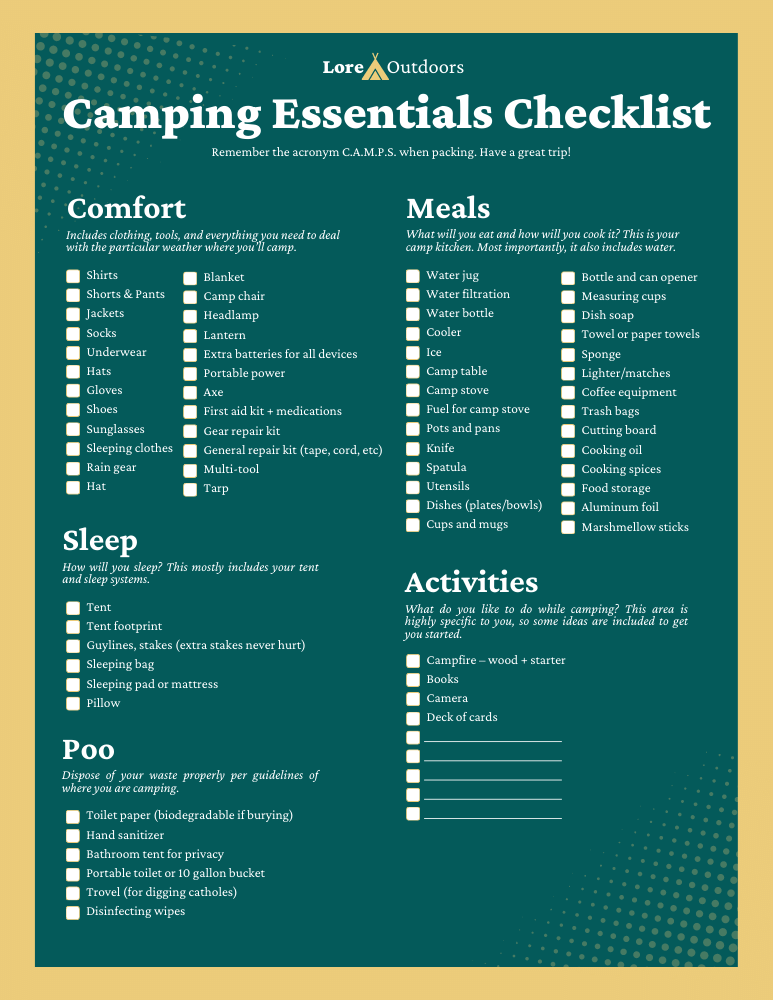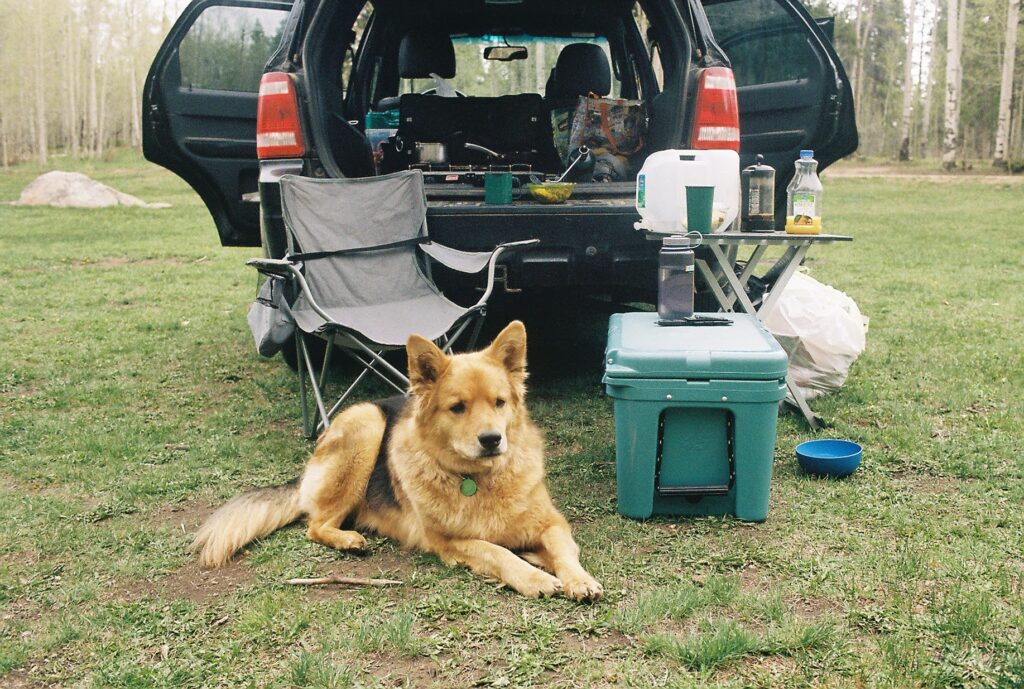If you go camping more than once a season, a water container should be on your gear list. Reusable containers give you the option of more storage without throwing away single-use jugs from the grocery store. They also offer extra features like durability, spigots, and more. Below you’ll find my recommendations for camping water containers as well as what to look for, different types of water storage options, and more. Here’s everything we’ll cover:
- The best water containers for camping
- How much water storage you need
- Which type of water container is best
- How long can water be safely stored?
- How to clean a camping water jug
- How to remove the chemical smell and taste from your water jug
- Water filtration options
The best water containers for camping
- Best overall — Scepter 2.5 gallon / Scepter 5 gallon green (or tan)
- Best budget — Reliance AquaTainer 7 gallon
- Best soft-sided/collapsible — WaterStorageCube 5 gallon
- Best for overlanding — RotopaX RX-2W 2 gallon
- Best water bladder — Hydrapak Seeker (2-4-6 gallon)
- Best water bottle — Nalgene
FYI: We’re a small team of outdoor experts and researchers that care about recommending quality, reliable outdoor products. If you choose to click a link and buy any of the products we recommend, we earn a commission at no additional cost to you.
Best Overall: Scepter 2.5 gallon / Scepter 5 gallon
Scepter water containers are military grade and well respected for a reason. They’re the most durable containers you can buy, offer wide mouth openings for easy cleaning, and small mouth openings for easy pouring. Yes, they’re pricey, but it’s a 10 year piece of kit.
For one person, a 2.5 gallon is enough for a weekend of camping. But add any more people, a pet, and fires to douse and I recommend going with the five gallon to be safe.
One knock against the Scepter is the tightness required to prevent any leakage if stored any way except up. There are attachments and ways to tighten down the lid, but for most people I’d say just to store it upright and you’ll be good to go. I would never store a water container in a direction it could easily leak anyway, and this seems to be a common theme with plastic water containers, so I don’t see it as a dealbreaker. The Scepters can come with some chemical smell at first, but use my cleaning ideas and you’ll be good to go. Check out their spout attachment too.
Best budget: Reliance AquaTainer 7 gallon
A classic choice. The AquaTainer offers excellent capacity in a rigid plastic frame, as well as an included spigot for easy pouring. The plastic isn’t as strong as the Scepter, and the small opening makes cleaning more difficult, but for basic camping needs the AquaTainer will take you far.
If you want extra water for safety and don’t think you’ll treat your gear too harshly this is a great choice that should still last for years.
Best soft-sided/collapsible — WaterStorageCube 5 gallon
If portability is your main concern then soft-sided water jugs may be right for you. The WaterStorageCube offers plenty of capacity with a collapsible frame to store it in your camping storage box after use. It also includes a spigot for easy pouring. Where it gains in packing and carrying it falls behind in durability and features, but if you’re easy on your gear the cube can be an affordable option to help in many scenarios, including around home.
Best for overlanding — RotopaX RX-2W 2 gallon
If you’re into overlanding you’re serious about your gear. You need equipment that’s tough, durable, and also flexible to fit with your specific setup. RotopaX is likely a brand you’ll recognize, and their RX-2W brings the popular jerry can design to the table. Attach it to your roof racks, plates, or other systems to keep two gallons of fresh water available whenever you need it. Seamless plastic design is just as strong if not stronger than the Scepter’s above, sacrificing capacity for the different mounting options necessary for overlanding on rough trails. It comes in 1, 1.75, and 2 gallon options for added flexibility.
Best water bladder — Hydrapak Seeker (2-4-6 gallon)
Moving away from large capacity containers, the Hydrapak Seekers are my pick for multi-use bladders. There are many options that work well in this type of water carrier, and their uses are usually more geared towards hiking and backpacking. But what I like about the Seeker is its flexibility. I own the two gallon version and have used it backpacking, ski touring, and as an extra pack of water in the car on road trips. The long, skinnier design than most bladder options helps it fit into tight bladder holders. They also offer a cap attachment and tube attachment to make it work just like bladders with built-in straws.
One con of the Seekers is a prevalent plastic taste in the water if stored for too long. It’s not a dealbreaker, but it’s been noticeable continually over time. See my tips below for getting rid of this.
Best water bottle — Nalgene
For your everyday carry needs in any situation you can’t go wrong with a Nalgene. They are durable, come in wide or small mouth options, and you can find one in just about any color you want. Slap some stickers on there from your favorite adventure spots and you’re good to go. I’ve used nalgene’s mountaineering, backpacking, and I’m drinking out of one while writing this. They’re a go-to for good reason.
How much water storage you need

For a typical weekend camping trip with me and my dog, I usually bring 3.5 gallons and have a bit left at the end. Your needs will depend on a few factors, and its worth thinking ahead of time about what you need water for to determine how much to bring. Here are common water uses while camping you should think about:
- Drinking—How many people? Pets? Are you going on strenuous hikes where you’ll drink more water?
- Cooking—Do you need water for any cooking needs? Do you drink coffee every morning and tea at night?
- Dousing fires—This is a big one if you live out west. Dousing fires is extremely important and uses water quickly.
- Washing dishes and gear
Water goes quickly when you think about all of the above, and in my opinion its always better to have more water than less water. If you’re dispersed camping in the wilderness filtering water is an option, and I’ll include some favorites below, but I like to enjoy my time in other ways. Once you’ve spent enough time filtering water during backpacking trips you don’t want to spend more time doing it than needed.
For two people camping I think five gallons of water is plenty for a weekend. This allows for all the uses above, enough to not worry about running out, to let a friend borrow some, or to have your pup along. If you’re just starting out don’t stress, you’ll learn how much you use over time, and unless you’re diving into the deep end of dispersed camping right away you should have water available in many campgrounds. It’s worth checking or calling your campground before you go to see if potable water is available. Many campgrounds have spigots but not all are potable, some just for washing up.

Use our printer-friendly checklist as a shopping list or packing list for your next camping trip.
Which type of water container is best

As you can tell from my list above, there are different options for water storage depending on your type of camping and specific needs. You can try burly plastic containers, collapsible soft-sided ones, bladders, water bottles, and more.
For most people tent camping, I recommend a hard-sided plastic container. They’re tough enough for most uses, not too expensive, and will last you for years. I don’t personally think the space savings of collapsible containers is worth the performance and risk of leakage. At very least, get some sort of reusable container so you aren’t throwing away plastic jugs every time you go camping. Your mileage will vary, so here are some factors to consider when choosing what type of water container to get.
Capacity (and access to water)
How much water do you need for your trip? Will potable water be available? If so, you may just need bladders and water bottles. I personally always bring a water container, a bladder, and a Nalgene on my camping trips. I use the smaller containers on hikes and keep the large container around the campsite.
Durability
How rough are you on your gear? Have you punctured things before, do you fling in gear when packing? How long you’re camping is also a factor here, as hard-sided containers offer more insulation and protection from the sun and other elements.
Type of camping
Do you need to lash your water to an overlanding kit? Are you simply packing it in the back of the car for the weekend? Dispersed camping in the wilderness always requires more water, and usually means you want a tougher storage solution as well. If you’re just hitting the campground at the state park then you might not need something like the Scepter.
How long can water be safely stored?
For 99% of camping trips this isn’t an issue. If you’re camping long enough for this to become an issue you are finishing your water and refilling it anyway. All the options I list above are BPA-free, which should reduce worry in the safety of the container itself. If you’re camping in the heat your water may become hot but this shouldn’t affect its potability over short periods of time. Don’t leave your water out in the hot sun, it’s not good practice for enjoyment or water quality.
The CDC says when water is properly stored in a sanitized container, it should be replaced every six months. So your camping trips shouldn’t be a problem as long as you’re cleaning your jug after use and filling it with safe water.
How to clean a camping water jug
There are multiple ways to properly clean your water containers and keep them safe for use. Here are a few tried and true methods you can try.
First is the most simple for day to day cleaning: warm water and dish soap. If you have a container like the Scepter with a wide opening you can easily reach in with a brush to scrub the sides, if not putting a mixture in and shaking it up will suffice. Let the mixture sit in the container for up to an hour before pouring it out and rinsing the interior completely with cold water. Then let it air dry.
If your container’s opening is too small to brush you can put rice in with the dishwashing liquid and water. Shaking the mixture around will introduce some abrasion to clean the interior. If you use rice I’d rinse it out afterwards and do another round with just dishwashing liquid and water to clean it further before rinsing.
For an intense clean, especially at the end of the camping season, you can follow the CDC’s guidelines for sanitization. You should do a deep clean at least twice a year to prevent bacteria buildup in your jug:
Before filling with safe water, use these steps to clean and sanitize water storage containers:
- Wash the storage container and rinse completely with water.
- Sanitize the container with a solution made by mixing 1 teaspoon of unscented liquid household chlorine bleach in 1 quart of water. Use bleach that contains 5%–9% sodium hypochlorite.
- Cover the container tightly and shake it well. Make sure the sanitizing bleach solution touches all inside surfaces of the container.
- Wait at least 30 seconds and then pour the sanitizing solution out of the container.
- Let the empty sanitized container air-dry before use OR rinse the empty container with safe water (water that has been treated).
- Pour clean water into the sanitized container and cover with a tight lid.
Distilled vinegar and baking soda are also options for this type of cleaning if you don’t have bleach or don’t want to use it.
How to remove the chemical smell and taste from your water jug
A common complaint for all types of plastic water containers is a chemical taste or smell lingering. It doesn’t feel right to drink water tainted by this, even if it isn’t dangerous. The cleaning methods above often help get rid of these issues, especially the more intense ones using bleach and baking soda. Letting your container sit overnight in the solution can help negate smells or tastes. For a Nalgene size water bottle, a teaspoon of bleach and baking soda in water is enough. Scale up the solution for the size of your container.
I’ve found baking soda to be the key to getting rid of unwanted chemical smell and tastes in my water containers. But if you don’t have it, vinegar can be a good substitute due to its acidity.
Note these cleaning methods also help if you have unwanted flavors stuck in water bottles, such as lemon taste sticking around.
Water filtration options
If you happen to need water filtration during your trip there are many options available. I’ll tell you, filtering gallons of water is time consuming and annoying. It’s an important part of backpacking trips but because of that I don’t like having to do it unless I need to. So my advice is to bring enough water or have a potable source available. But if you end up needing it you can choose from a few options.
- Gravity system—One of the easiest ways to passively filter larger amounts of water. Gravity systems provide a consistent source of water you can filter as needed, just hang it somewhere around camp and fill up your cup or water bottle as needed. I recommend the LifeStraw Peak Series, which you can get in 3L or 8L options.
- Bottle cap filters and pumps—The Katadyn BeFree is always with me on backpacking trips. It’s easy to use, doubles as its own water bottle, and doesn’t take up much space. It’s treated me well, but squeezing water through it can be tiring and I’ve experienced some blockage in the filter before. Other popular options in this range of filter are the Sawyer squeeze system or the LifeStraw for emergencies and small amounts.
- Integrated jerry can—The most expensive yet convenient option. The Lifesaver jerry can has an integrated filter and spout letting you fill it up and pour filtered water as needed. The price matches its features, but it’s a highly respected solution if you want to splash the cash.
- Iodine tablets—These are my least favorite option, but they’re good to have around in a pinch. Put them in your water to disinfect it before drinking. They’re trustworthy but they impart a taste on your water most people don’t like. I usually keep a bottle of them in my pack just in case something goes wrong with a filter.
This is more for backpacking, but I like to have two options of water filtration available just in case one goes wrong. Redundancy is your friend and there’s nothing more important than clean drinking water when in the backcountry.
FAQs
How much water should I bring camping?
For two people on a weekend camping trip, five gallons should be plenty.
Do longer camping trips change what type of water storage you need?
In most cases, no. I think you should decide what type of water storage to use based on how much water you need, what type of camping you do, and how durable you need your storage to be. If you’re out camping for a long time its more likely you’ll need to add filtration to the mix versus changing your container.
What container is best for storing water?
Hard-sided plastic containers are the best overall solution for water storage. They are durable, trustworthy, long lasting, and offer excellent capacity.
What types of water storage containers are there?
The most common type of water storage containers are plastic containers or jugs, soft-sided collapsible containers, bladders, and water bottles.
Are collapsible water containers good?
They are good for saving space when not in use. But know they aren’t as durable or strong as hard-sided containers.
What are water storage containers called?
They can be called water containers, jugs, bottles, bladders, and more! Don’t worry, most the terms are interchangeable, but these are the terms you should use when searching for them.
How do you sanitize a water jug?
Shake a mixture of warm water and dishwashing liquid, let it sit for an hour, then rinse with cold water and air dry. For deeper sanitization clean with a water/bleach solution or with baking soda to kill any bacteria. You should deep clean your water jug at least twice a year with bleach and/or baking soda.
Keep your water clean
Water is life, luckily its a really easy thing to solve for when camping. Bring more than you think you need when first starting out and you’ll never put yourself in a pickle. I hope this guide helped you think through different water storage options and what may be right for you. If you have any thoughts or feedback please let me know by reaching out to [email protected]. Happy drinking!
Alex Eaton
I'm Alex, the founder of Lore. My life outside started with camping trips in southern Indiana as a kid, and has taken me across the world. My goal is to give you the tools and confidence you need to pursue the outdoor life you want.
Use our printer-friendly checklist as a shopping list or packing list for your next camping trip.